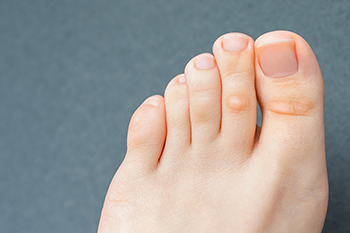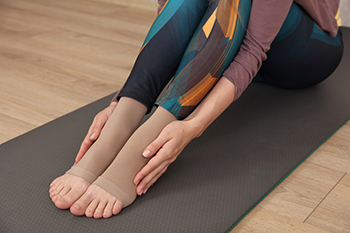Connect With Us
Blog
Items filtered by date: April 2022
Foot Corn Treatment

A foot corn is a hardened layer of skin that develops on the foot due to friction or pressure. Foot corns can develop below the toenail bed, between toes, or on the sides and bottom of the feet. Most often, corns develop from snug shoes and/or socks and become aggravated from prolonged periods of standing or walking, body weight, and continual friction, causing them to become painful. If you suspect you have a corn on your foot your first action should be to change footwear to those that fit properly. You can try to soften a corn by carefully soaking the affected foot in warm water with Epsom salts, drying the foot thoroughly, and moisturizing it daily. Once softened, you can try to gently rub the corn on the bottom of the foot with a pumice stone. Using an emery board, if the corn is located between the toes, you can apply a vegetable-based oil and cover it with a corn pad that can be obtained from a drug store. Continue this treatment for a couple of weeks. However, if there is pain associated with home treatment or the corn persists or worsens, it is suggested that you seek guidance from a qualified podiatrist to assist in treating the corn.
Corns can make walking very painful and should be treated immediately. If you have questions regarding your feet and ankles, contact Stephen Boykins, DPM of SoCal Podiatry, P.C.. Our doctor will treat your foot and ankle needs.
Corns: What Are They? And How Do You Get Rid of Them?
Corns are thickened areas on the skin that can become painful. They are caused by excessive pressure and friction on the skin. Corns press into the deeper layers of the skin and are usually round in shape.
Ways to Prevent Corns
There are many ways to get rid of painful corns such as:
- Wearing properly fitting shoes that have been measured by a professional
- Wearing shoes that are not sharply pointed or have high heels
- Wearing only shoes that offer support
Treating Corns
Although most corns slowly disappear when the friction or pressure stops, this isn’t always the case. Consult with your podiatrist to determine the best treatment option for your case of corns.
If you have any questions please feel free to contact our offices located in Downey and Moreno Valley, CA . We offer the newest diagnostic and treatment technologies for all your foot and ankle needs.
Risks of an Achilles Rupture
When you experience a complete tear of the Achilles tendon in the ankle, it is called an Achilles rupture. The list of those most likely to have this condition can include: men over 40, athletes who play sports such as football, tennis, or rugby, women who wear high heels, athletes who consistently ignore Achilles pain, and athletes who have had a recent ankle injury, overpronate, or have a thinner Achilles tendon. Still other risk factors include being overweight, taking certain medications, or using corticosteroids. What does a ruptured Achilles tendon feel like? It reportedly feels like someone has kicked or hit you in the back of the heel. Ignoring the warning signs, such as a pain that builds gradually or the pain from another ankle injury, increases the risk of such a tear. To avoid this occurrence, it is a good idea to see a podiatrist, who can perform a full biomechanical analysis to determine whether you may need orthotics or specific stretching and strengthening exercises. It is possible to recover from this painful event, but prevention is better.
Achilles tendon injuries need immediate attention to avoid future complications. If you have any concerns, contact Stephen Boykins, DPM of SoCal Podiatry, P.C.. Our doctor can provide the care you need to keep you pain-free and on your feet.
What Is the Achilles Tendon?
The Achilles tendon is a tendon that connects the lower leg muscles and calf to the heel of the foot. It is the strongest tendon in the human body and is essential for making movement possible. Because this tendon is such an integral part of the body, any injuries to it can create immense difficulties and should immediately be presented to a doctor.
What Are the Symptoms of an Achilles Tendon Injury?
There are various types of injuries that can affect the Achilles tendon. The two most common injuries are Achilles tendinitis and ruptures of the tendon.
Achilles Tendinitis Symptoms
- Inflammation
- Dull to severe pain
- Increased blood flow to the tendon
- Thickening of the tendon
Rupture Symptoms
- Extreme pain and swelling in the foot
- Total immobility
Treatment and Prevention
Achilles tendon injuries are diagnosed by a thorough physical evaluation, which can include an MRI. Treatment involves rest, physical therapy, and in some cases, surgery. However, various preventative measures can be taken to avoid these injuries, such as:
- Thorough stretching of the tendon before and after exercise
- Strengthening exercises like calf raises, squats, leg curls, leg extensions, leg raises, lunges, and leg presses
If you have any questions please feel free to contact our offices located in Downey and Moreno Valley, CA . We offer the newest diagnostic tools and technology to treat your foot and ankle needs.
Do You Suffer From Painful Feet?
What Might Be Causing Your Child’s Heel Pain
Active, growing children that experience pain in their heels may have a condition known as Sever’s disease. The cause of this pain stems from irritation of the growth plate in the heel bone, as it has not yet completely developed and calcified. Bones in the calf grow more rapidly than the Achilles tendon, which attaches to the heel bone where the growth plate is located. This difference in growth can cause tightness and pressure in the Achilles tendon, which is often exacerbated with physical activity—particularly sports that involve running and jumping. Icing the area and refraining from activities that make the pain worse can sometimes help ease the pain. For professional pain relief, make an appointment with a podiatrist. They can offer a variety of pain management techniques, such as custom orthotics and heel raises, personalized stretching routines, footwear recommendations, and prescription pain medications.
Sever's disease often occurs in children and teens. If your child is experiencing foot or ankle pain, see Stephen Boykins, DPM from SoCal Podiatry, P.C.. Our doctor can treat your child’s foot and ankle needs.
Sever’s Disease
Sever’s disease is also known as calcaneal apophysitis, which is a medical condition that causes heel pain I none or both feet. The disease is known to affect children between the ages of 8 and 14.
Sever’s disease occurs when part of the child’s heel known as the growth plate (calcaneal epiphysis) is attached to the Achilles tendon. This area can suffer injury when the muscles and tendons of the growing foot do not keep pace with bone growth. Therefore, the constant pain which one experiences at the back of the heel will make the child unable to put any weight on the heel. The child is then forced to walk on their toes.
Symptoms
Acute pain – Pain associated with Sever’s disease is usually felt in the heel when the child engages in physical activity such as walking, jumping and or running.
Highly active – Children who are very active are among the most susceptible in experiencing Sever’s disease, because of the stress and tension placed on their feet.
If you have any questions, please feel free to contact our offices located in Downey and Moreno Valley, CA . We offer the newest diagnostic and treatment technologies for all your foot and ankle injuries.
Do You Have Poor Blood Circulation in Your Feet?
 Seniors are particularly susceptible to poor blood circulation that can often affect the feet. Symptoms to look for in checking your feet for poor circulation are numbness, tenderness, cramping, swelling, coldness, and discoloration (paleness, white patches on skin and toenails), particularly after physical activity or prolonged standing. It should be considered a critical situation if your feet turn blue as this usually means they are not receiving enough oxygen due to poor circulation. If you have wounds on your feet that are slow to heal, this can also be a sign that blood circulation to your feet is problematic. As one ages, and foot problems become more common, it is a good idea to visit a podiatrist regularly to have your feet examined and tended to. It is particularly important to seek treatment if you suspect poor blood circulation in the feet because, if left untreated, serious problems such as varicose veins and amputation can result.
Seniors are particularly susceptible to poor blood circulation that can often affect the feet. Symptoms to look for in checking your feet for poor circulation are numbness, tenderness, cramping, swelling, coldness, and discoloration (paleness, white patches on skin and toenails), particularly after physical activity or prolonged standing. It should be considered a critical situation if your feet turn blue as this usually means they are not receiving enough oxygen due to poor circulation. If you have wounds on your feet that are slow to heal, this can also be a sign that blood circulation to your feet is problematic. As one ages, and foot problems become more common, it is a good idea to visit a podiatrist regularly to have your feet examined and tended to. It is particularly important to seek treatment if you suspect poor blood circulation in the feet because, if left untreated, serious problems such as varicose veins and amputation can result.
While poor circulation itself isn’t a condition; it is a symptom of another underlying health condition you may have. If you have any concerns with poor circulation in your feet contact Stephen Boykins, DPM of SoCal Podiatry, P.C.. Our doctor will treat your foot and ankle needs.
Poor Circulation in the Feet
Peripheral artery disease (PAD) can potentially lead to poor circulation in the lower extremities. PAD is a condition that causes the blood vessels and arteries to narrow. In a linked condition called atherosclerosis, the arteries stiffen up due to a buildup of plaque in the arteries and blood vessels. These two conditions can cause a decrease in the amount of blood that flows to your extremities, therefore resulting in pain.
Symptoms
Some of the most common symptoms of poor circulation are:
- Numbness
- Tingling
- Throbbing or stinging pain in limbs
- Pain
- Muscle Cramps
Treatment for poor circulation often depends on the underlying condition that causes it. Methods for treatment may include insulin for diabetes, special exercise programs, surgery for varicose veins, or compression socks for swollen legs.
As always, see a podiatrist as he or she will assist in finding a regimen that suits you. A podiatrist can also prescribe you any needed medication.
If you have any questions, please feel free to contact our offices located in Downey and Moreno Valley, CA . We offer the newest diagnostic and treatment technologies for all your foot care needs.



